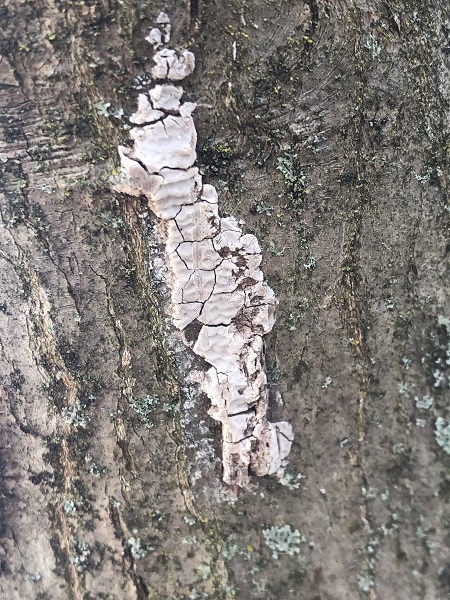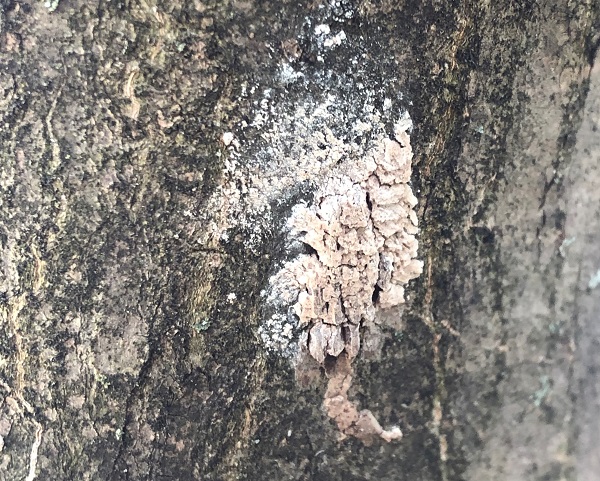ALERT: Check your trees, the invasive spotted lanternfly has hatched!
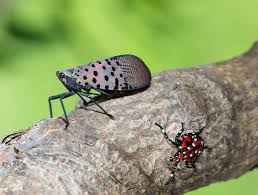
I stepped outside on this blustery Tuesday to water some plants when I remembered that I wanted to check in with my red maple tree that has been infested with Spotted Lanternflies for the past two years. As many of you may know, the Spotted Lanternfly is an invasive fly that arrived in Berks County, Pennsylvania in 2014. The Spotted Lanternfly is native to China, Bangladesh, and Vietnam. Despite its beauty, it has wreaked havoc on native hardwood trees used in the lumber industry and decimated fruit trees and grape vines used in agriculture – the fly’s presence is estimated at $324 million in annual damage to the PA economy (source: PSU Extension). Maple, willow, black walnut, and birch trees as well as grape vines, apple trees, and hops plants are all susceptible to being destroyed by lanternflies. In addition to economic damage, trees and plants that we enjoy around our houses can sustain significant damage, even death, from the lanternfly infestation. When the lanternflies feed on trees, they excrete a sticky sweet substance that attracts wasps and other insects, which you also may not want infesting your property. You can read more about the threats of this pest at the Penn State Extension link here. While this blog is intended to be about loving and appreciating nature, not destroying it, there are some incredibly invasive species that do not belong here and must be dealt with or the health of our entire native ecosystem will suffer.
Before it leafed out this year, I’d gotten a chance to scrape some of the invasive bug’s egg masses off of the red maple in my backyard. The tree is maybe 40 ft tall, and I couldn’t reach other egg masses without a ladder. I’d been meaning to get to it, but it just kept slipping off the to-do list. Today, to my utter dismay, the egg masses have begun to hatch. I’m writing this post as a PSA — the next generation of lanternflies has hatched for the season, so please check your trees for egg masses and recently hatched nymphs.
If you find any egg masses or newly hatched nymphs, here’s what you can do to get rid of them:
Identifying Spotted Lanternfly Life Stages
There are 3 main stages of lanternfly development, and this picture from the Penn State Extension is really excellent for identifying them. Early nymphs are present from May to October and are black with white spots (Image B). Late nymphs are red with black spots, are larger than early nymphs (and those suckers can really jump!) and are present from late June through October (Image C). The recognizable spotted lanternfly with wings is present from July to December (Images D and E). Egg masses (Image A) are highlighted in the next section. 
Identifying Egg Masses
To find the lanternfly egg masses, look for a light-ish colored spot on the tree – it might initially resemble a lichen, but on closer inspection it will look like a smear of dirt on the tree. When freshly laid, the egg masses are a darker brown, but in spring/summer they will be light brown and may be starting to crack. You might be able to see little rows of eggs peaking out from under the protective dirt layer. Often these can be found on the underside of tree branches and under parts of the tree where branches split, where they are sheltered from the rain and elements. Egg masses can be found on any surface, including the exterior of houses and even cars, so be alert for these in other areas around your property. Both of these pictures are of egg masses on my Japanese maple trees, which seem less susceptible to lanternfly damage, but that may be because they prefer the red maple in my yard.
Removing Egg Masses
Get a ziplock bag and a putty knife. Open the bag under the egg mass, and using the putty knife, scrape into the bag. For good measure, you can fill the bag with alcohol and double bag it before throwing it away, or just lay it flat and squish any eggs that fall in with the putty knife. Not a fun job, but you are helping the ecosystem and the economy.
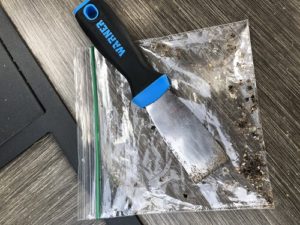
Removing Nymphs and Adults
With the tiny guys that have hatched, I have been able to collect some of them using a similar method to the removal of egg masses by flicking them with the putty knife into the baggy and then squishing them. Nymphs and adults can jump pretty far, so just watch out when you try to touch them! You can spray them with an insect killer, but you can also just squish them and save some chemicals. The adults may fly and land on you, but they don’t seem to bite.
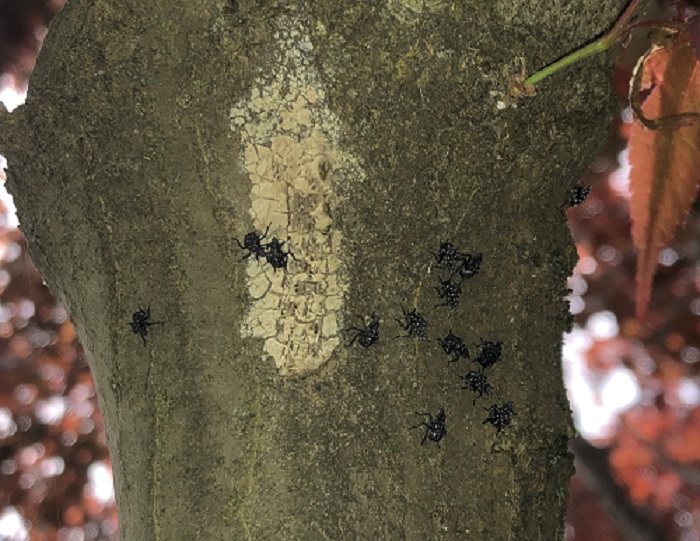
Management
Unfortunately the tree is far too tall and too expansive for me to manage by hand, so I have resorted to using chemical insecticides to treat it. I hate hate HATE resorting to this, but I could not kill enough lanternflies by hand to protect the tree (I used to use a long painters pole and stand out there whacking at flies for several hours at a time and wondered if my neighbors might have me committed…). Two years ago, I had a foliar spray applied, which resulted in short term death of many lanternflies as well as some other insects living in the tree. A large yellow, innocent orbweaver spider was one of the victims, falling drunkenly out of the tree attached to her web, and eventually succumbing to the poison. It was heartbreaking to watch. Last year, the PA Department of Agriculture updated their recommendations to a trunk injection of systemic insecticide that gets distributed throughout the tree from root to tip and is supposed to last 1 year. When lanternflies feed on the tree, they will die. The Dept of Ag is also looking into other less invasive methods, like a fungus that kills the lanternflies. Other treatments include removing the preferred host plant, the Tree of Heaven, and banding target trees with bands of sticky tape. These sticky bands work only in the short term, when the lanternflies are in their nymph stages, and are useless after the lanternflies grow wings. They also have the potential to trap unsuspecting animals like squirrels and birds that may come in contact with the sticky band, so they should be used with caution and should have a protective cage applied around them.
If you choose not to chemically treat, I totally understand — instead, using bands, hunting for egg masses, and stomping on any you find around your yard still helps protect our ecosystem. The following PA counties are technically in the “quarantine zone” (man, does quarantine have a different meaning now with the advent of COVID-19…): Allegheny, Beaver, Berks, Blair, Bucks, Carbon, Chester, Columbia, Cumberland, Dauphin, Delaware, Huntingdon, Juniata, Lancaster, Lebanon, Lehigh, Luzerne, Mifflin, Monroe, Montgomery, Northampton, Northumberland, Perry, Philadelphia, Schuylkill, and York. Unfortunately, they have also begun spreading to New Jersey, Delaware, Maryland, Virginia, and West Virginia. We are supposed to check our cars as we leave the quarantine area to make sure we aren’t taking any hitchhikers to other areas of the country that don’t have active infestations. A quick glance at the underside of your car before you leave can help reduce the spread of this damaging pest. This is another good reason why you shouldn’t transport firewood from one area to another, as invasive species of insects and plants can be transported this way. If you are going to spend upcoming weekends camping, do some research and find a local spot to buy firewood from near your campsite. Many campgrounds offer it and local homeowners with some land may sell firewood – just keep an eye out for informal stands on the way up to your camping spot.
I hope this was informative and helps you combat the Spotted Lanternflies you might find in your own yards.
